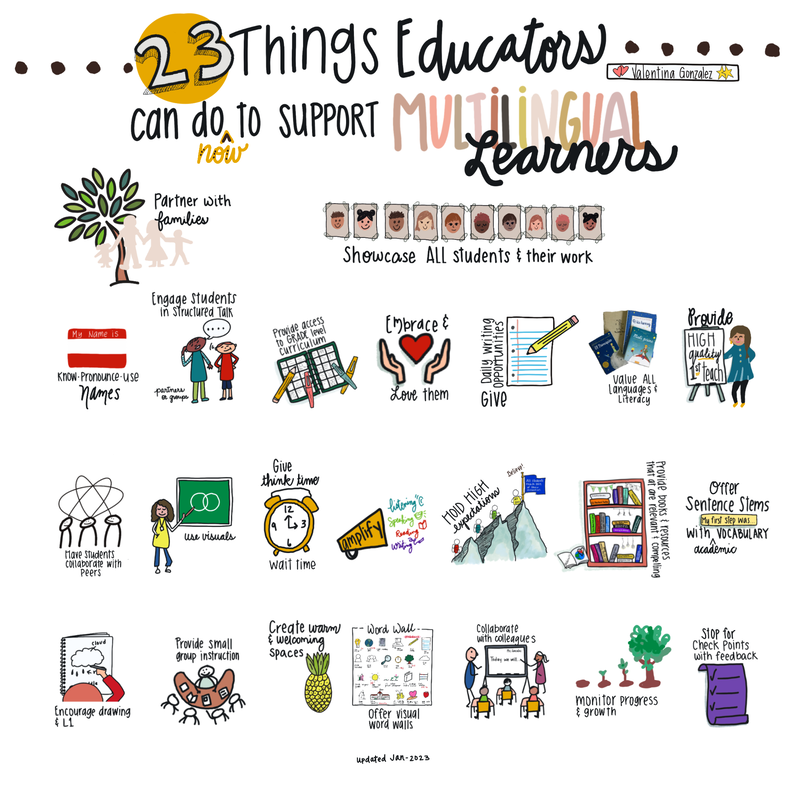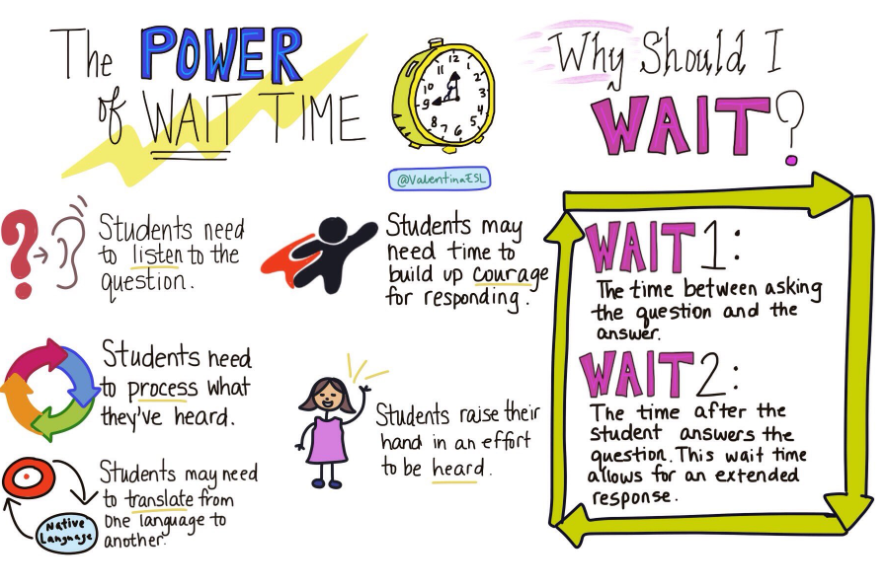|
Last year this article was shared and greatly loved. This year, I'm adding to it to include one additional support. Multilingual learners count on us to provide high-quality, comprehensible, and culturally responsive instruction in each lesson in every classroom. Here are 23 practical and efficient ways (in no particular order) we can support multilingual learners as they climb to become our future global leaders. *The terms multilingual, emergent bilingual, and English learner are used interchangeably in this article and also include the acronyms MLs, EBs, and ELs. 1. Showcase ALL Students and Their Work. Displaying pictures of students and their families on the walls helps each learner to feel seen and validated in the learning space. This creates a sense of belonging and builds community among the class. Hanging student work on the walls, such as writing and art, can also send clear messages to learners that the classroom is for learners and learning. 2. Know, Pronounce, & Use their Names. That’s right. Validating a student’s identity with their given name is important. Avoid making an “American” name for a child. If you aren’t sure how to pronounce a name, ask, repeatedly if needed. Some teachers have students record how they prefer to be called on Flipgrid. This allows the teacher and classmates to replay the video/sound at their leisure as many times as necessary. 3. Engage Students in Structured Talk. Structuring talk among classmates offers emergent bilinguals the chance to discuss with peers in a routine that focuses on academic language. A Structured conversation (like QSSSA) lightens the cognitive load so students need not worry about who their partner will be, who talks first, or how to begin the conversation. Their energy is placed directly on the content. 4. Provide Access to Grade Level Curriculum. When Emergent bilinguals have access to grade-level curriculum with linguistic accommodations and scaffolds they are less likely to fall behind academically. It’s important to remember that acquiring a language is not a deficit, but rather that a first language is an asset that can be used as leverage. 5. Embrace and Love Them. Kids that think their teachers love them and feel they are loved for who they are, achieve more. Even if a child can’t speak English yet, they can still think and feel. A smile goes a long way. 6. Give Daily Writing Opportunities. No matter the subject area you teach, have students write. Writing does not need to be a lengthy process nor must it be a ticket out (though it can be). Writing can include predictions, thoughts, reflections, comparisons, justifications, etc. Writing can also include modeling by you, sentence stems, primary language, and drawing as needed by students. 7. Value ALL Language and Literacy. Many teachers will say that they value languages and literacy but how can we quantify that belief in our daily work with students? Actions speak louder than words, right?
8. Provide High-Quality 1st Teach. This is a big one. MLs who receive initial instruction that is insufficient will often fall further behind academically and linguistically. When this happens over an extended period of time, many MLs have difficulty exiting state ESL programs and are often labeled LTELs (or long-term English learners). On the other hand, those that receive high-quality, first teach that amplifies language and is comprehensible, thrive academically and develop language simultaneously. 9. Have Students Collaborate With Peers. Through peer collaboration, students learn in ways that we, teachers, can’t provide. As Vygotsky taught us, learning is social. When multilingual collaborate with monolingual English-speaking peers the reciprocal learning that happens among them is invaluable. Group work, Jigsaw approach, literature circles, and book clubs are just a few examples of collaborative settings. 10. Use Visuals. Visuals transcend all languages. When we see a visual representation, no matter the language we speak, we can begin to access our prior knowledge and schema.
11. Give Think Time/Wait Time. After posing a question, wait about 3-5 seconds before calling on students or having them talk to one another. This wait time allows emergent bilinguals time to think, process, translate, and build the courage to respond. Studies show that the extra wait time increases the number of students’ responses and the quality of responses. 12. Amplify Listening, Speaking, Reading, and Writing. Years ago, the idea was that when working with English learners we needed to simplify instruction so they could understand it. Now we know that we can “KEEP the content and amplify the language” (listening, speaking, reading, and writing). This was a quote a heard Okhee Lee say during a presentation she did for teachers of ELs. No more watering down curriculum. Scaffold UP! 13. Hold High Expectations. Multilingual students are brilliant. We have to believe they CAN DO it! With our support, they can do everything monolingual English speakers can do. We set the ceiling for them. It’s a matter of how high are our expectations. What do we believe? Our belief creates potential and that potential builds action. Action creates results. The cycle continues. Believe big! 14. Provide Books & Resources that are Relevant & Compelling. Take a look at the books and resources in front of you. Then take a look at the students. Do they align? Will students be interested? Will they find themselves? Will they connect? Will they see others and others’ experiences? If not, this is your call to action. 15. Offer Sentence Stems with Academic Vocabulary. Sentence stems and sentence starters are excellent ways to scaffold academic language in any classroom K-12. If we want students to speak and write using academic language structures and vocabulary, sometimes we have to literally put those structures and vocabulary into their mouths. Sentence stems are scaffolds that can help emergent bilinguals begin to acquire English language structures that differ from the language structures in their primary language. 16. Encourage Drawing & L1. When we look at learners from their assets, we recognize that there are many ways to express ideas, share information, demonstrate knowledge, and be creative. English (or any language) does not determine intelligence. Allowing students to draw, sketch, and use their L1 (or first language) helps them recognize that thinking and learning are valued. 17. Provide Small Group Instruction. Gathering students in small groups helps to lower the student-teacher ratio allowing for more intimate instruction. A small group can be one-to-one like a conference between the student and the teacher or a group of 3-5. It’s important that small groups be fluid and heterogeneous to avoid stigmatizing learners. Multilingual learners benefit from small group instruction because it can lower the affective filter and provide time for direct and explicit instruction with the careful guidance of the teacher. 18. Create Warm & Welcoming Spaces. Classroom environments that capture kids' hearts will no doubt build their minds and allow language to flourish. The goal is for English learners and their families to feel safe to take risks and feel that they belong and are valued in our campuses and our classrooms. 19. Offer Visual Word Walls. Imagine moving to a new country and not speaking the language yet. Look at the word wall. It’s only words on index cards. No visuals to help you understand. You can read them, but you have no clue what they mean. Frustrating right?! Visual word walls are accessible to more learners in our classrooms. We can even add words in our EBs’ primary language(s) or add realia. 20. Collaborate with Colleagues. Collaborating with our colleagues helps our students. We need each other. Our colleagues know things that we don’t know and we can learn from one another. As an ESL Co-Teacher and later an ESL Facilitator, I had the honor of going into classrooms and working alongside numerous teachers on my campus/district. That was the best professional learning. Our peers are our greatest teachers! 21. Monitor Progress & Growth. If we want emergent bilinguals to grow in language and content, we need to know where they are and become intentional about the steps to help them get to the goals. Goal setting alongside EBs has become a more common practice too. Many teachers sit alongside students to discuss goals and progress. 22. Stop for Checkpoints with Feedback. Formatively assessing during lessons helps us to form the next steps in instruction. I think of formative assessment (checkpoints) as a thermometer. We take the temperature and then based on the results, we adjust the thermostat (instruction) and provide feedback to students. On the other hand, if we rarely stop to check on students’ understanding, we might go for hours or days not realizing that students have missed key understandings. Large gaps may form and by this time it becomes difficult to re-route the learning that has solidified. 23. Partner with Families. Family members and caregivers of MLs are often the strongest experts of their children. They know them better than most other people. We can achieve many things by brining in family members, tapping into their expertise, helping them see their own value as partners in the educational journey, and just by simply creating environments where students feel that their entire being is accepted, loved, and welcomed-including their families. Going beyond a single parent-teacher conference, we can learn more about caregivers and ask them to join us hand in hand as we help our children learn and grow. So there they are, again, in no particular order. 23 ways to support multilingual learners in everyday instruction. For the original post of this article, click here: https://www.valentinaesl.com/articles-for-educators/22-things-educators-can-do-now-to-support-multilingual-learners
Comments are closed.
|
Categories
All
|



 RSS Feed
RSS Feed
